Zhiheng Lyu
ScholarCopilot: Training Large Language Models for Academic Writing with Accurate Citations
Apr 03, 2025Abstract:Academic writing requires both coherent text generation and precise citation of relevant literature. Although recent Retrieval-Augmented Generation (RAG) systems have significantly improved factual accuracy in general-purpose text generation, their ability to support professional academic writing remains limited. In this work, we introduce ScholarCopilot, a unified framework designed to enhance existing large language models for generating professional academic articles with accurate and contextually relevant citations. ScholarCopilot dynamically determines when to retrieve scholarly references by generating a retrieval token [RET], which is then used to query a citation database. The retrieved references are fed into the model to augment the generation process. We jointly optimize both the generation and citation tasks within a single framework to improve efficiency. Our model is built upon Qwen-2.5-7B and trained on 500K papers from arXiv. It achieves a top-1 retrieval accuracy of 40.1% on our evaluation dataset, outperforming baselines such as E5-Mistral-7B-Instruct (15.0%) and BM25 (9.8%). On a dataset of 1,000 academic writing samples, ScholarCopilot scores 16.2/25 in generation quality -- measured across relevance, coherence, academic rigor, completeness, and innovation -- significantly surpassing all existing models, including much larger ones like the Retrieval-Augmented Qwen2.5-72B-Instruct. Human studies further demonstrate that ScholarCopilot, despite being a 7B model, significantly outperforms ChatGPT, achieving 100% preference in citation quality and over 70% in overall usefulness.
PixelWorld: Towards Perceiving Everything as Pixels
Jan 31, 2025Abstract:Existing foundation models typically process visual input as pixels and textual input as tokens, a paradigm that contrasts with human perception, where both modalities are processed in a unified manner. With the rise of embodied and agentic AI, where inputs primarily come from camera pixels, the need for a unified perception framework becomes increasingly evident. In this paper, we propose to unify all modalities (text, tables, code, diagrams, images, etc) as pixel inputs, i.e. "Perceive Everything as Pixels" (PEAP). We introduce PixelWorld, a novel evaluation suite that unifies all the mentioned modalities into pixel space to gauge the existing models' performance. Our findings show that (1) PEAP outperforms baseline with token-based input in multimodal datasets, benefiting from unified input for better disambiguation, (2) significant declines in reasoning and coding capabilities across all models when processing pixel-based input, underscoring the need to enhance foundation models' perceptual abilities, (3) larger models can maintain strong performance on non-reasoning tasks under PEAP, while smaller models like Phi-3.5-V suffer significant performance degradation, (4) the attention pattern of PEAP is highly aligned with text token input, (5) PEAP can be accelerated significantly by exploiting the spatial sparsity. We conclude that the existing frontier models are competent in pixel perception, however, there is still headroom for improvement. Our code, dataset will be released upon acceptance.
FACTTRACK: Time-Aware World State Tracking in Story Outlines
Jul 23, 2024Abstract:While accurately detecting and correcting factual contradictions in language model outputs has become increasingly important as their capabilities improve, doing so is highly challenging. We propose a novel method, FACTTRACK, for tracking atomic facts and addressing factual contradictions. Crucially, FACTTRACK also maintains time-aware validity intervals for each fact, allowing for change over time. At a high level, FACTTRACK consists of a four-step pipeline to update a world state data structure for each new event: (1) decompose the event into directional atomic facts; (2) determine the validity interval of each atomic fact using the world state; (3) detect contradictions with existing facts in the world state; and finally (4) add new facts to the world state and update existing atomic facts. When we apply FACTTRACK to contradiction detection on structured story outlines, we find that FACTTRACK using LLaMA2-7B-Chat substantially outperforms a fair baseline using LLaMA2-7B-Chat, and achieves performance comparable to a GPT4 baseline. Moreover, when using GPT4, FACTTRACK significantly outperforms the GPT4 baseline.
VideoScore: Building Automatic Metrics to Simulate Fine-grained Human Feedback for Video Generation
Jun 24, 2024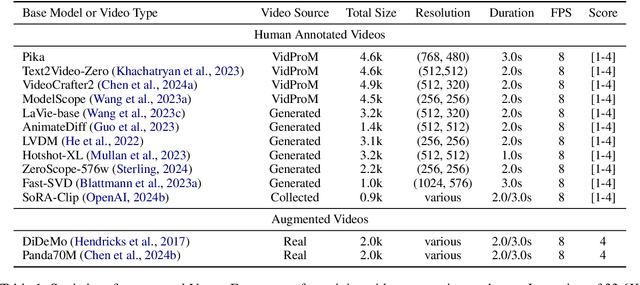

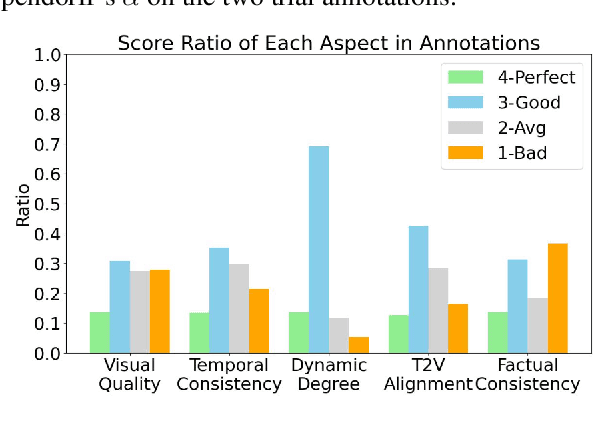

Abstract:The recent years have witnessed great advances in video generation. However, the development of automatic video metrics is lagging significantly behind. None of the existing metric is able to provide reliable scores over generated videos. The main barrier is the lack of large-scale human-annotated dataset. In this paper, we release VideoFeedback, the first large-scale dataset containing human-provided multi-aspect score over 37.6K synthesized videos from 11 existing video generative models. We train VideoScore (initialized from Mantis) based on VideoFeedback to enable automatic video quality assessment. Experiments show that the Spearman correlation between VideoScore and humans can reach 77.1 on VideoFeedback-test, beating the prior best metrics by about 50 points. Further result on other held-out EvalCrafter, GenAI-Bench, and VBench show that VideoScore has consistently much higher correlation with human judges than other metrics. Due to these results, we believe VideoScore can serve as a great proxy for human raters to (1) rate different video models to track progress (2) simulate fine-grained human feedback in Reinforcement Learning with Human Feedback (RLHF) to improve current video generation models.
On the Causal Nature of Sentiment Analysis
Apr 17, 2024



Abstract:Sentiment analysis (SA) aims to identify the sentiment expressed in a text, such as a product review. Given a review and the sentiment associated with it, this paper formulates SA as a combination of two tasks: (1) a causal discovery task that distinguishes whether a review "primes" the sentiment (Causal Hypothesis C1), or the sentiment "primes" the review (Causal Hypothesis C2); and (2) the traditional prediction task to model the sentiment using the review as input. Using the peak-end rule in psychology, we classify a sample as C1 if its overall sentiment score approximates an average of all the sentence-level sentiments in the review, and C2 if the overall sentiment score approximates an average of the peak and end sentiments. For the prediction task, we use the discovered causal mechanisms behind the samples to improve the performance of LLMs by proposing causal prompts that give the models an inductive bias of the underlying causal graph, leading to substantial improvements by up to 32.13 F1 points on zero-shot five-class SA. Our code is at https://github.com/cogito233/causal-sa
CLadder: A Benchmark to Assess Causal Reasoning Capabilities of Language Models
Dec 07, 2023Abstract:The ability to perform causal reasoning is widely considered a core feature of intelligence. In this work, we investigate whether large language models (LLMs) can coherently reason about causality. Much of the existing work in natural language processing (NLP) focuses on evaluating commonsense causal reasoning in LLMs, thus failing to assess whether a model can perform causal inference in accordance with a set of well-defined formal rules. To address this, we propose a new NLP task, causal inference in natural language, inspired by the "causal inference engine" postulated by Judea Pearl et al. We compose a large dataset, CLadder, with 10K samples: based on a collection of causal graphs and queries (associational, interventional, and counterfactual), we obtain symbolic questions and ground-truth answers, through an oracle causal inference engine. These are then translated into natural language. We evaluate multiple LLMs on our dataset, and we introduce and evaluate a bespoke chain-of-thought prompting strategy, CausalCoT. We show that our task is highly challenging for LLMs, and we conduct an in-depth analysis to gain deeper insight into the causal reasoning abilities of LLMs. Our data is open-sourced at https://huggingface.co/datasets/causalNLP/cladder, and our code can be found at https://github.com/causalNLP/cladder.
Can Large Language Models Infer Causation from Correlation?
Jun 09, 2023Abstract:Causal inference is one of the hallmarks of human intelligence. While the field of CausalNLP has attracted much interest in the recent years, existing causal inference datasets in NLP primarily rely on discovering causality from empirical knowledge (e.g., commonsense knowledge). In this work, we propose the first benchmark dataset to test the pure causal inference skills of large language models (LLMs). Specifically, we formulate a novel task Corr2Cause, which takes a set of correlational statements and determines the causal relationship between the variables. We curate a large-scale dataset of more than 400K samples, on which we evaluate seventeen existing LLMs. Through our experiments, we identify a key shortcoming of LLMs in terms of their causal inference skills, and show that these models achieve almost close to random performance on the task. This shortcoming is somewhat mitigated when we try to re-purpose LLMs for this skill via finetuning, but we find that these models still fail to generalize -- they can only perform causal inference in in-distribution settings when variable names and textual expressions used in the queries are similar to those in the training set, but fail in out-of-distribution settings generated by perturbing these queries. Corr2Cause is a challenging task for LLMs, and would be helpful in guiding future research on improving LLMs' pure reasoning skills and generalizability. Our data is at https://huggingface.co/datasets/causalnlp/corr2cause. Our code is at https://github.com/causalNLP/corr2cause.
Voices of Her: Analyzing Gender Differences in the AI Publication World
May 24, 2023



Abstract:While several previous studies have analyzed gender bias in research, we are still missing a comprehensive analysis of gender differences in the AI community, covering diverse topics and different development trends. Using the AI Scholar dataset of 78K researchers in the field of AI, we identify several gender differences: (1) Although female researchers tend to have fewer overall citations than males, this citation difference does not hold for all academic-age groups; (2) There exist large gender homophily in co-authorship on AI papers; (3) Female first-authored papers show distinct linguistic styles, such as longer text, more positive emotion words, and more catchy titles than male first-authored papers. Our analysis provides a window into the current demographic trends in our AI community, and encourages more gender equality and diversity in the future. Our code and data are at https://github.com/causalNLP/ai-scholar-gender.
Psychologically-Inspired Causal Prompts
May 02, 2023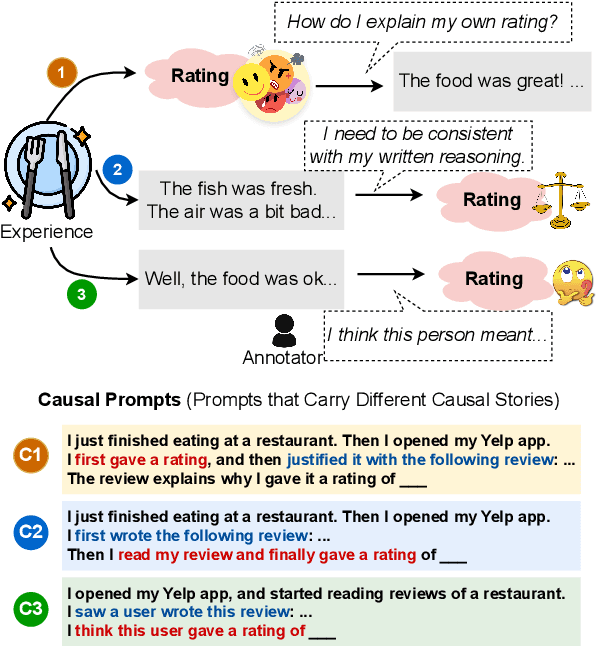


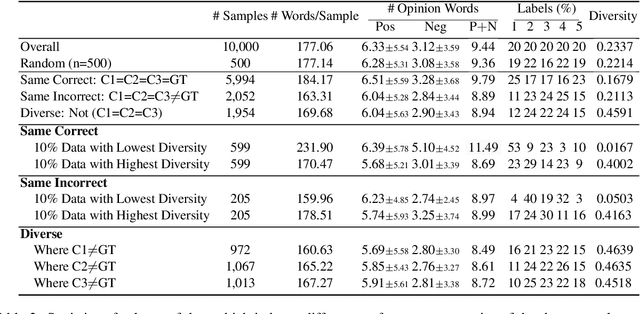
Abstract:NLP datasets are richer than just input-output pairs; rather, they carry causal relations between the input and output variables. In this work, we take sentiment classification as an example and look into the causal relations between the review (X) and sentiment (Y). As psychology studies show that language can affect emotion, different psychological processes are evoked when a person first makes a rating and then self-rationalizes their feeling in a review (where the sentiment causes the review, i.e., Y -> X), versus first describes their experience, and weighs the pros and cons to give a final rating (where the review causes the sentiment, i.e., X -> Y ). Furthermore, it is also a completely different psychological process if an annotator infers the original rating of the user by theory of mind (ToM) (where the review causes the rating, i.e., X -ToM-> Y ). In this paper, we verbalize these three causal mechanisms of human psychological processes of sentiment classification into three different causal prompts, and study (1) how differently they perform, and (2) what nature of sentiment classification data leads to agreement or diversity in the model responses elicited by the prompts. We suggest future work raise awareness of different causal structures in NLP tasks. Our code and data are at https://github.com/cogito233/psych-causal-prompt
Logical Fallacy Detection
Feb 28, 2022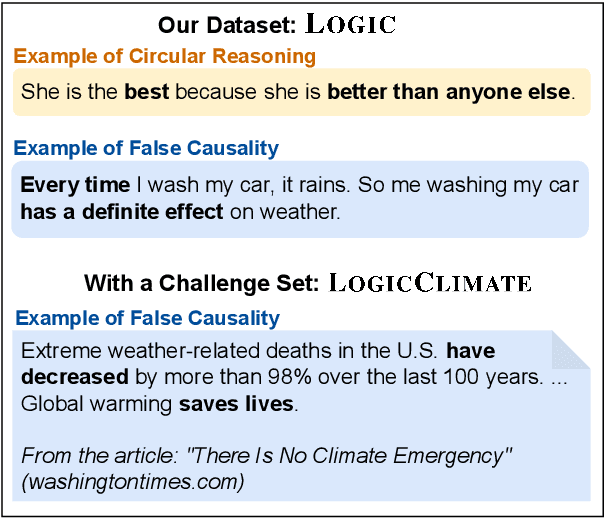
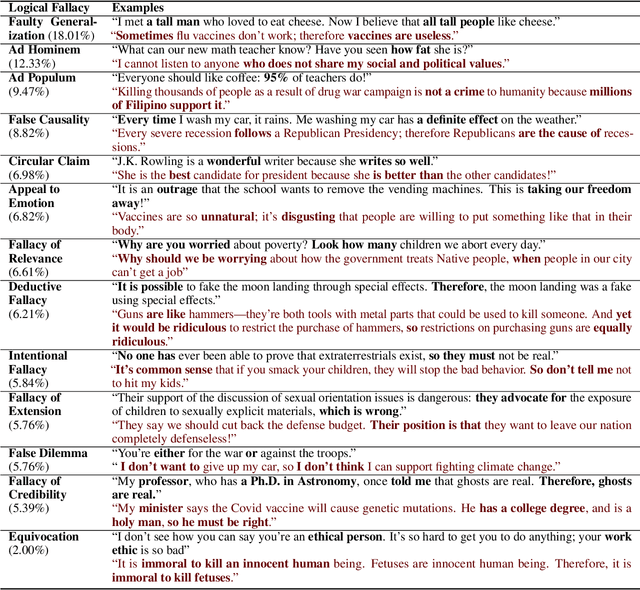

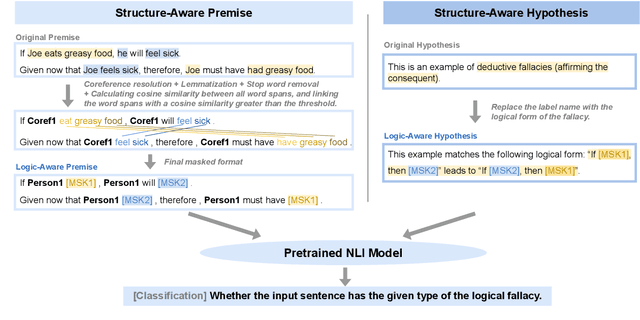
Abstract:Reasoning is central to human intelligence. However, fallacious arguments are common, and some exacerbate problems such as spreading misinformation about climate change. In this paper, we propose the task of logical fallacy detection, and provide a new dataset (Logic) of logical fallacies generally found in text, together with an additional challenge set for detecting logical fallacies in climate change claims (LogicClimate). Detecting logical fallacies is a hard problem as the model must understand the underlying logical structure of the argument. We find that existing pretrained large language models perform poorly on this task. In contrast, we show that a simple structure-aware classifier outperforms the best language model by 5.46% on Logic and 3.86% on LogicClimate. We encourage future work to explore this task as (a) it can serve as a new reasoning challenge for language models, and (b) it can have potential applications in tackling the spread of misinformation.
 Add to Chrome
Add to Chrome Add to Firefox
Add to Firefox Add to Edge
Add to Edge